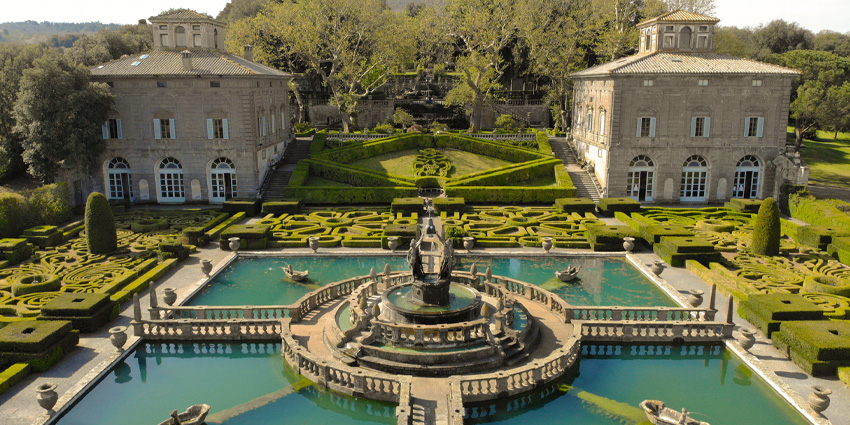
Villa Lante Bagnaia: a Renaissance Masterpiece of Gardens, Architecture, and History
Villa Lante, located in Bagnaia, a charming village near Viterbo in the Lazio region of Italy,
is considered one of the finest examples of Renaissance architecture and garden design. Built during the second half of the 16th century, it perfectly embodies the principles of balance, order, and harmony that defined the cultural ideals of its time. Unlike many other Renaissance villas that were conceived as imposing single residences, Villa Lante is unique for its composition: two symmetrical palazzine immersed in an extraordinary Italian-style garden, where water features and monumental fountains play a central role.
Historical Background
The origins of Villa Lante are closely linked to the patronage of Cardinal Gianfrancesco Gambara, who commissioned the initial works in the 1560s. The project is traditionally attributed to Jacopo Barozzi da Vignola, one of the leading architects of the Renaissance. Later, the estate was further enriched by Cardinal Alessandro Peretti Montalto, who expanded and embellished both the buildings and the gardens.
The architectural choice of designing two twin palazzine rather than a single large residence reflects the innovative character of the villa. The Palazzina Gambara and the Palazzina Montalto face each other, separated yet united by the garden, which becomes the true protagonist of the entire complex.
The Italian Renaissance Gardens
The gardens of Villa Lante are regarded as one of the most significant achievements in the history of landscape architecture. Following the principles of the Italian Renaissance garden, they are structured in terraces that gradually descend along the natural slope of the land. Geometric layouts, perfectly aligned axes, and carefully designed perspectives guide the visitor’s eye through fountains, staircases, and avenues of centuries-old trees.
Among the most iconic features are:
- The Fountain of the Quadrato (Square Fountain), which marks the central axis of the first terrace.
- The Fountain of the Dolphins, decorated with playful marine figures.
- The Catena d’Acqua (Water Chain), an ingenious hydraulic feature where water flows down a carved stone channel in the form of intertwining crayfish tails, symbolizing Cardinal Gambara’s heraldic emblem.
- The Fountain of the Four Moors, perhaps the most famous element of the garden, where four statues surround the central basin and support the heraldic mountain of Cardinal Montalto.
The hydraulic system of Villa Lante, still functioning after centuries, represents one of the most advanced examples of Renaissance engineering, designed to astonish visitors with spectacular water games and symbolic meanings.
Artistic and Architectural Details
The two palazzine, though smaller than other grand Renaissance villas, are richly decorated with frescoes and stuccoes that enhance their elegance. Inside the Palazzina Gambara, the rooms are adorned with fresco cycles that include mythological themes, allegories of the seasons, and landscapes that celebrate the harmony between man and nature. The Palazzina Montalto, on the other hand, reflects the taste and ambitions of Cardinal Montalto, with decorations that emphasize his family’s power and prestige.
The artistic language of the villa combines classical references with allegorical elements, turning every detail—from sculptures to fountains—into a symbolic narrative. Nature is never left in its raw form but is instead shaped, ordered, and celebrated as a reflection of human ingenuity.
Cultural Significance and Legacy
Villa Lante Bagnaia is internationally recognized as one of the masterpieces of Renaissance garden design. Its significance lies not only in its aesthetic perfection but also in the cultural values it expresses. The villa embodies the Renaissance vision of nature tamed by reason and art, where landscape, architecture, and symbolism converge into a unified whole.
Over the centuries, Villa Lante has inspired scholars, architects, and artists, and it continues to be studied as a model of harmony between built environment and natural setting. Alongside other renowned Renaissance gardens such as Villa d’Este in Tivoli, Villa Lante represents the pinnacle of Italian garden art and is considered among the most beautiful in Europe.
Villa Lante and the Tuscia Territory
The location of Villa Lante in the heart of Tuscia, a historical region north of Rome, enhances its cultural value. The surrounding area is rich in medieval towns, Etruscan heritage, thermal springs, and natural landscapes, making the villa part of a wider cultural and historical itinerary. Bagnaia itself retains the charm of a Renaissance village, with its historic center and narrow streets leading to the entrance of the villa.
Visiting Villa Lante means entering a world where history, art, and nature coexist in perfect balance. It is not only a testimony to Renaissance ideals but also a living monument that preserves the creativity, ingenuity, and elegance of one of the most important periods in Italian history.



